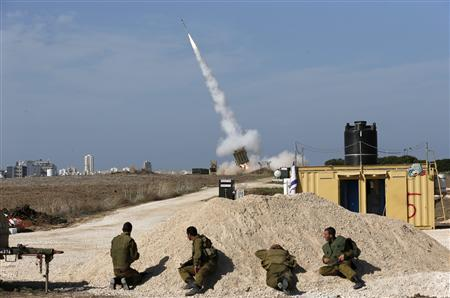What Is The Iron Dome? Israeli Missile Defense System Intercepts Overwhelming Number Of Hamas Rockets

Though Hamas fighters have fired hundreds of rockets into Israel in recent days, the onslaught has had minimal impact with no reported injuries, demonstrating that the tiny country can protect its citizens with one of the most futuristic and effective missile defense systems in the world: the Iron Dome.
Reports vary, but Hamas fighters are said to have fired between 175 and 250 rockets into Israel by Wednesday afternoon, with 45 of them aimed at major cities including Jerusalem, Tel Aviv, and Hadera, according to the Israeli army. Dozens were eliminated by Israel’s Iron Dome, a high-tech air defense system that uses radar to assess whether an incoming rocket is expected to strike a heavily populated area and then use that information to prevent potentially hundreds of casualties.
“The radar detects a rocket launch and passes information regarding its path to the control center, which calculates the predicted point of impact,” the Israel Defense Force told CNN. “If this location justifies an interception, a missile is fired to intercept the rocket. The payload of the interceptor missile explodes near the rocket, in a place that is not expected to cause injuries.”
The interceptors are also capable of operating on their own in the event they lose communication with the command center.
Tension between Israel and Hamas, the Palestinian political and military force that has governed the Gaza Strip since 2007, has spiked in the weeks since three Israeli teenagers were kidnapped and murdered in the West Bank. Israel blamed Hamas for the slayings, retaliating by arresting Hamas members and those close to them. That led to a series of missile attacks into Israel, with the fighting expected to continue.
Israel began construction on the Iron Dome in 2007 and, if the IDF's information is accurate, the technology has proven to be an overwhelming success. Israel and Hamas last clashed in November 2012, when 1,500 rockets were launched from the Gaza Strip.
The IDF said in 2012 that 84 percent of the missiles were intercepted. This time, the Haaretz newspaper reported that the Iron Dome had achieved a 90 percent success rate between Monday night and Wednesday afternoon, adding that “there have been few rocket hits or serious injuries.”
Rafael Advanced Defense Systems, Israeli's government-owned military technology company, was the initial developer of the Iron Dome nearly 10 years ago, but the United States has also dedicated substantial resources to the project. The U.S. provided $235 million for further Iron Dome research, with each dome battery costing $50 million and each missile costing $62,000, according to the Congressional Research Service.
“This is a program that has been critical in terms of providing security and safety for Israeli families,” President Obama Barack has said in the past. “It is a program that has been tested and has prevented missile strikes inside of Israel.”
And there is little room for error, if the past 48 hours are any indication. The Iron Dome intercepted one rocket and allowed two others to land in open areas Wednesday afternoon at Dimona in southern Israel. Dimona is the location of Israel’s nuclear reactor and, while the Jerusalem Post reported that there was no indication of damage to the reactor, the near-miss shows that the missile attacks are only becoming more threatening.
The Iron Dome is constantly being updated and will expand in the future, because the lives of so many civilians are put at risk when tensions rise and fall with Hamas, say Israeli Air Force officials. That expansion was given another shot in the arm when the U.S. Congress authorized an additional $680 million for it through 2015.
“There is something in the pipeline, both in terms of hardware and software improvements,” a Rafael executive told Jane’s Defense Weekly earlier this year, as quoted by the Guardian. “I can’t say exactly what there are or when they might be rolled out, but we are in a kind of race [with the Palestinian rocketers] and we always need to update [the system] to increase the probability of a kill.”
A number of videos have surfaced in recent days showing the Iron Dome as it polices the skies over Israel.
© Copyright IBTimes 2025. All rights reserved.





















